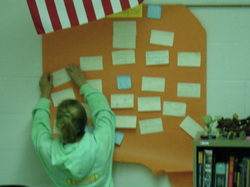
Yesterday, in class, we wanted to get the students thinking about the rest of the year and what things relating to world history they wanted to learn more about. Instead of coming into class with a pre-generated detailed lesson plan and syllabus on what we were going to teach, what students would be learning and how they would learn it; we gave the reigns to the students. We want students to take ownership of the class and the content we discuss. The goal is to create students that are invested in the discussion, assignments and projects they do within the class. Students feel empowered to control their learning destiny. It wasn’t just lip service either; Mike and I are going to make the curriculum fit what students want to study.
The past couple of weeks we’ve discussed culture and introduced different aspects, or parts, of culture. We started this with a project Garth created called “What was 7th Grade like?”. Students look into their own lives and family history to uncover culture/cultural diffusion from the recent past; the decade their parent(s) were in 7th grade. We incorporated higher level questioning skills, interview and research skills with students through this project. Now that students had an idea of what makes “culture”, we introduced the foundation of the class, which is the concept of civilization.
We posed a question: “what characteristics do you think a group of people have to possess to be considered a civilization?” Having a list of characteristics for civilizations, we told the students to think… Think about what you want to learn appropriate to a class entitled “world history”. That was their homework. Not a worksheet. No questions or short answers. Simply to think about class outside of the school. It is our first attempt at the new “no homework” policy in our class.
So, today students came prepared to discuss and debate what they had thought about. Many students came with their lists of questions (which was not required), and those that didn’t necessarily write those down, had a couple minutes to organize their thoughts on paper.
Around the classroom we hung large colored poster boards with the different characteristics of civilizations: geography, government, the arts, economy, religion, social structure and an “everything else” category. We gave each student post-it notes to write their best questions down, whether it was all 5 or just 1. It wasn’t the quantity that mattered; it was the quality. After writing their questions on separate post-it notes, students stuck them to their desks. They then had to rotate to a new seat somewhere else in the classroom and were given the task to take another student’s post-it notes and stick them onto the correct colored poster board around the classroom.
This lesson incorporated the different modalities of learning as the students discussed with each other their questions by means of think/pair/share (auditory), wrote down the questions and sorted them onto colored poster boards (visual), and had the opportunity to physically handle the post-it notes while walk around the room to find the right category (kinesthetic).
Watching this in an inclusion setting with students identified with disabilities, it was impossible to distinguish between students of varying abilities. Listening the student’s conversations, we heard tons of higher-level questioning as they asked each other questions and debated about certain areas.
...We are developing patient-learners who value quality not quantity
-Jenna
 RSS Feed
RSS Feed


